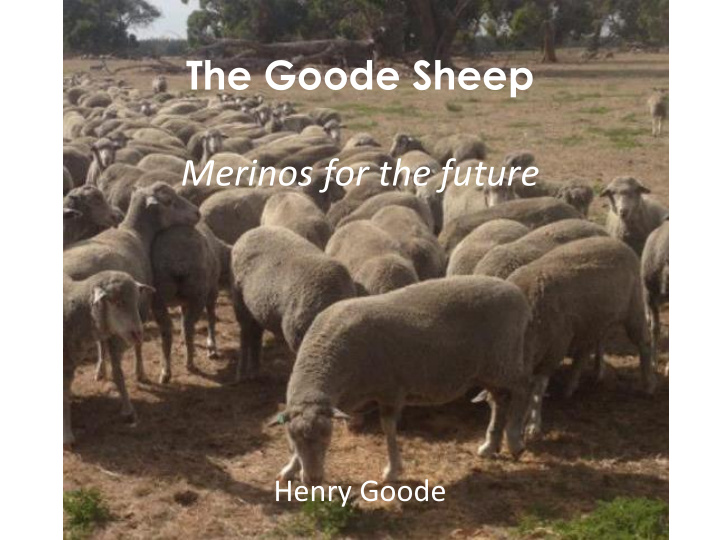



The Goode Sheep Merinos for the future Henry Goode
Property - Barooka • Approx 2800 hectares • Mt Benson region • Dad & Myself work on farm, brother Tom occasional • 5600 breeding ewes • 2000 mated ewe lambs • 350 shorthorn cow herd • 210ha centre pivot irrigation – Lucerne for grazing – 40ha Leased to potato grower
Sheep overview • Recently moved from 50% merino 50% first cross prime lambs • To 100% self-replacing merino operation • Glendemar MPM (Multi-Purpose Merinos) genetics for 15 years – Very plain bodied easy-care sheep – Adult sheep average 18-20 micron – Ewe size 60kg at CS3
Sheep overview • Found a progressive stud with aims that suit us • Buy rams each year • Breed own rams from small nucleus flock as not economical to buy all ram replacements • Hogget's classed off-shears in November bare shorn • Currently averaging 100% lambing to ewes mated • Through fine-tuned nutrition and management, plan to increase to 120% and beyond
Genetics – ASBV’s • Fat (YFAT) • Ewe fertility , lamb survival , ability to cope with tough times • Eye Muscle Depth (PEMD) • Improved carcase shape, dressing % , ewe reproduction • Growth (PWT) • Fast lamb turnoff and ability to mate ewe lambs • Staple Length (YSL), Clean Fleece Weight (CFW) • Free growing, bold crimping , white wool
14 month old ewe hogget
No mulesing • No mulesing for 10 years • Result of classing for thin skins, no wrinkle, clean points and bare breech • Free growing, soft, white wool followed because of this
No mulesing • Te pari docking iron used for 10 years • Rotating anvil stretches wool during docking • End of tail heals with bare skin rather than wool • Prevents dags forming on end of tail – Reduce tail strike
Modern merinos • Since beginning with Glendemar genetics – Reduced ewe frame, weight by 10kg – Easier handling and shearing ewes – Reduced micron by 5 micron – Increased wool length by 20% – Faster growing, robust lambs with carcase that would rival some XB’s – Near non-existent body and tail strike – Less chemicals and labour – No mulesing or jetting – Sacrificed wool cut by 10%
Joining ewes • Ewes managed using LTEM principles • Join in mostly large mobs 1000+ • Lupin/Lucerne flushing • Teasers for 2 weeks to induce ram effect • 5 week joining
Labour saving and accurate feeding
Lambing • Preg-scan for twins/singles at day 90 • Main lambing 15 th June • Pushed out 2 weeks later this year • Twin ewes – preferentially feed to increase birthweights and CS – Lamb down in mobs 150 or less – Allocate best paddocks for feed on offer (FOO) and shelter – Ideally 1500-2000kgDM/ha
Lambing • Single ewes – Maintain CS 3 until lambing – Lamb down in mobs no more than 250 – 800+kgDM/ha • Wet and dry ewes at marking – Drys sold after shearing
Weaning • Lambs are weaned at 8-12 weeks old – Usually average approx . 25kg liveweight – Run in large mobs on irrigated and dryland lucerne, cocksfoot, phalaris mixes • Wether lambs turned off from 6 to 10 months old, 21kg/cw sold into the trade
2017 Ewe lambs • Ewe lambs run on dry-land Lucerne all summer • Were weighed at 8 months old – 15% drafted off (lambs below 45Kg) – The main mob averaged 54kg lw – Estimated 15kg heavier than at same time than previous years
2017 Ewe lambs • Teased for 2 weeks • Lambs joined at 8 months old • Rams in at 5% for 5 week joining still running on Lucerne
6 month shearing • Began 6 month shearing in 2015 • Were being discounted for overgrown wool, around 120mm+ • Now shear May, November
Benefits 6 month shearing • Tensile strength increased from 25 Newtons to around 60 Newtons – Eliminated tender wool • Cutting 60-70mm each shearing – Ewes cut approx 3kg 6 monthly – Better meeting market for length specifications • Increased amount of fleece wool by 10% • Less skirtings
Benefits 6 month shearing • Now crutch on average 10% of flock pre-shearing • Spend same amount of time in shed because of minimal crutching • Sheep ‘do better’ and are easier to manage • Hope ewes find better shelter to lamb in • 3 processors trying to source our un-mulesed wool
Future goals • Wean 120% lambs from ewes mated • Cut 4kg wool every 6 months • Cut 90mm of wool every 6 months in 10 years time • Turn off all wether lambs by 9 months at 24kg/cw • Implement RFID tags throughout flock • Receive individual carcase feedback from abattoirs including individual grading • Continue to produce ethically treated and sustainable products for the consumers
Thank you
Recommend
More recommend